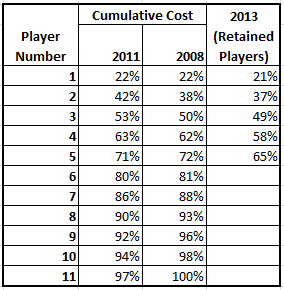So finally after a really long delay the rules for the IPL Auction 2014 are out. Each franchise has the option of retaining up to five players, with additional “trump cards” that allow them to match the price of a winning bid in the auction for players that were part of their teams in the earlier IPLs.
At the outset, the rules of the auction look loaded towards teams that already have strong squads and want to retain as many players as they can – for example, given the rules of the auction, a team can retain up to 6 players from their existing squads, and this significantly biases the auction in favour of teams that want to retain players.
Looking a bit deeper, though, it is clear that this luxury of retention comes at a price. For example, irrespective of what the team negotiates with its number one player, Rs. 12.5 Crore (125 million), or a little more than 20% of the cumulative salary cap will be debited from the team’s account. For the next player, Rs. 9.5 Crore (95 million) will be debited. There is a sliding scale and the fifth player a team retains will cost them Rs. 4 Crore in terms of their budget.
The question is if this pricing is appropriate – is charging 20% of the team budget for the number one player enough compensation for the benefit the team gets by way of retention? Is charging two thirds of the total salary cap (Rs. 39 Crore) enough for retention of five players?
At first look, this pricing looks appropriate – after all, why would someone want to forego two thirds of their auction kitty for keeping just five players, when the total squad size is 16 to 27? However, looking at the previous auctions tells a different story.
The two graphs here shows the proportion of total auction money spent by each team on each player in the last two auctions. The graph might appear complicated so let me explain. For each team, I ordered players bought in the auction in the descending order of price. Then I looked at how much the top player cost as a proportion of the total money spent at the auction. Then, how much the top two players cost and so on.

(click on images for full size. For the 2008 auction, marquee players have been included in the analysis)
In the 2008 auction, teams spent between 60 and 85% of their budgets in order to select their five most expensive players, with a median of 72%. In the 2011 auction, teams spent between 65 and 90% of their budgets for their top five players (takes into account retained players), and the median spend was 71%.
Given that the “top 5” players for each team cost them upwards of 70% of their total budgets in the last two auctions, charging teams only Rs. 39 Crore (65%) for retaining five players is blatantly unfair, and biased towards the teams that want to retain. Also, considering that retained players are “known devils”, there is more value for money for teams from retained players. So in the ideal case, the fee for retaining 5 players should have been definitely upwards of 75% of the total budget (Rs. 45 Crore).
The following table helps to show the undervaluation of each retained player:
The second and third columns in the above table shows the median percentage of total budget teams spent in order to buy their top N players. The last column shows what percentage of their budget they would have to spend if they are to retain players in the auction.
The message for teams is clear: retain as much as you can. It is cheaper to retain your top players rather than building a new team from the available pool. The challenge, however, is to negotiate a good price with these players.
PS: I have a solution that can help teams plan their auction strategy. If you are an IPL team and you are interested in this, contact me through the contact form.


Well, I reckon the key point of your post (with all those totally unnecessary plots and all!) is that it takes a lesser proportion of the salary cap to retain your players, than to build a team. Don’t you think that’s totally subjective. I mean in the end, regardless of how much you want to put a “Quant” spin to this, I think it’s got more to do with talent-spotting and getting your money’s worth. And that depends on the nature of players you already have.